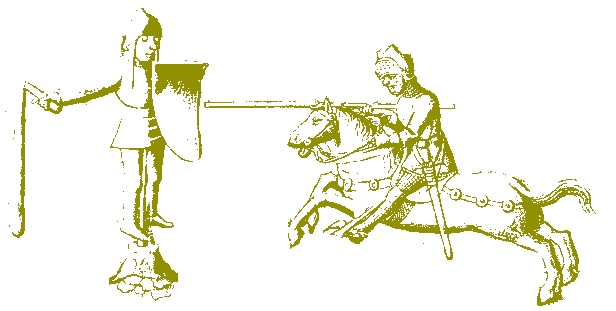| SOME NOTES ON MEDIEVAL ENGLISH GENEALOGY | ||||
| HOME | GUIDE | SOURCES | FAMILIES | RESOURCES |
| LINKS | CALENDAR |
Request updates WHAT'S NEW |
THIS SITE | SEARCH |

For a variety of reasons (which presumably boil down to the facts that the British are islanders and incurable bureaucrats), Britain - and particularly England - is extremely fortunate in the quantity of surviving records of medieval government. These include not only one-off spectacular productions like the Domesday Book but also, more importantly, the dull, everyday productions of administrative machinery, accumulated over centuries. Some classes of these records exist in essentially unbroken sequence from the 12th century onwards. Moreover, a huge number of them have been printed (often in English translation) and indexed.
The two main 'departments' of medieval government were the Chancery and the Exchequer. The Chancery began as the king's secretariat, staffed by clerics and presided over by the Chancellor, who was originally the king's chaplain. It was responsible for producing royal charters, letters and so on, and for keeping enrolled records of them. The Exchequer - named after a chequered cloth used for monetary calculations - was the financial department, responsible for the receipt and issue of the king's revenue. Its records are voluminous, and include a huge number of accounts, tax assessments and surveys of land tenure. Other potentially useful records were generated by the medieval courts of law (including the judicial arms of the Chancery and the Exchequer). Naturally, the system never remained static, but was in a continual state of evolution. There were particularly marked changes under the Tudors, when much of the Chancellor's administrative responsibilites passed to the Secretaries of State, and the Chancery became predominantly a court of equity.
Space on this web site is, in theory, unlimited, but unfortunately time, skill and knowledge are severely constrained. The following pages cover a selection of the public records which can be most useful to the genealogist. I have tried to group them into reasonably sensible and convenient sections, but inevitably there are some overlaps and some anomalies.
But it's worth bearing in mind that almost any type of record could contain an informative reference to an ancestor, and that searching certainly shouldn't be limited to the classes mentioned here. More detailed information is available in the published works listed below. Nearly all the surviving medieval English public records (apart from a few stray documents) are held by the Public Record Office, which has an excellent web site. This contains a variety of useful information, including introductory leaflets, an online searchable catalogue - which already includes a huge number of references to individuals - also a class-by-class description of the records, including details of printed calendars and indexes. Some links to useful pages within the P.R.O. site are given below, and in the following sections.
Another forthcoming source of information is a database of English medieval (and early modern) records, to appear on the Association for the Promotion of Scholarship in Genealogy web site [formerly at http://www.apsg.org/; not available, 2 November 2003]. This will include discussion, examples, bibliography and guidance, with the admirable aim of teaching 'the public how to competently pursue original research during this period'.
Many of the public records have been printed in some form, and I have tried to list the main published editions in the following pages. These cover a period of more than 200 years, and things have changed a great deal over that time. The earliest editions attempted to reproduce as closely as possible the abbreviated medieval Latin texts, using a specially designed record type, and translations were not usually provided. Later it would be more common for extended Latin transcripts to be printed, with the abbreviations eliminated. Finally English abstracts, or editions of parallel text and translation, became the norm (although some records continue to be published in Latin alone). It is worth bearing in mind that, as a rule, more recent editions are likely to be more accurate than older ones - such as the often unreliable productions of the Record Commission in the early 19th century. It's also unfortunate that a surprising number of the older volumes appeared without an index - particularly some in the series of Deputy Keepers' Reports and Lists and Indexes. This has partly been remedied by subsequent indexing, and by the production of the new online P.R.O. catalogue.
| Public records: Domesday Book > |